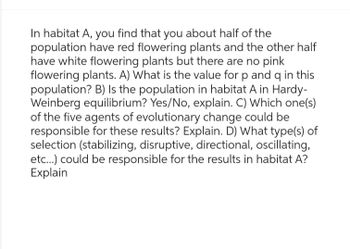
Biology: The Dynamic Science (MindTap Course List)
4th Edition
ISBN: 9781305389892
Author: Peter J. Russell, Paul E. Hertz, Beverly McMillan
Publisher: Cengage Learning
expand_more
expand_more
format_list_bulleted
Concept explainers
Question
Please Aspa

Transcribed Image Text:In habitat A, you find that you about half of the
population have red flowering plants and the other half
have white flowering plants but there are no pink
flowering plants. A) What is the value for p and q in this
population? B) Is the population in habitat A in Hardy-
Weinberg equilibrium? Yes/No, explain. C) Which one(s)
of the five agents of evolutionary change could be
responsible for these results? Explain. D) What type(s) of
selection (stabilizing, disruptive, directional, oscillating,
etc...) could be responsible for the results in habitat A?
Explain
Expert Solution
This question has been solved!
Explore an expertly crafted, step-by-step solution for a thorough understanding of key concepts.
Step by stepSolved in 3 steps

Knowledge Booster
Learn more about
Need a deep-dive on the concept behind this application? Look no further. Learn more about this topic, biology and related others by exploring similar questions and additional content below.Similar questions
- David Hills of Baylor University noted that three closely related species of leopard frog (genus Rana) exhibit substantialbut not completepostzygotic reproductive isolation when crossed in the laboratory. Field surveys of numerous populations in Texas and surrounding states revealed that populations of the three species breed at various times during the year. Data on the breeding schedule of both allopatric and sympatric populations of these species are presented in the Figure below. Interpret the data in the figure and explain how they may demonstrate that these frogs experience prezygotic reproductive isolation in nature. What type of prezygotic reproductive isolation do the data suggest? Source: D.M. Hillis. 1981. Premating isolating mechanisms among three species of the Rana pipiens complex in Texas and southern Oklahoma. Copeia 1981:312-319.arrow_forwardIn which of the following pairs do both evolutionary processes introduce new genetic variation into a population? a. natural selection and genetic drift b. mutation and gene flow c. natural selection and gene flow d. gene flow and genetic driftarrow_forwardGalapagos medium ground finches are found on Santa Cruz and San Cristóbal islands, which are separated by about 100 km of ocean. Occasionally, individuals from either island fly to the other island to stay. This can alter the allele frequencies of the population through which of the following mechanisms? a. natural selection b. genetic drift c. gene flow d. mutationarrow_forward
- Which of the following is not part of how we define a species? a. Its individuals appear different from other species. b. It is reproductively isolated from other species. c. Its populations can interbreed. d. Fertile offspring are produced.arrow_forwardWhy might captive-breeding programs that reintroduce species into natural environments fail?arrow_forwardINTERPRET DATA The genotype frequencies of a population are determined to be 0.6 BB. 0.0 Bb, and 0.4 bb. Is it likely that this population meets all the conditions required for genetic equilibrium?arrow_forward
- According to the punctuated equilibrium model, (a) populations slowly diverge from one another (b) the evolution of species occurs in spurts interspersed with long periods of stasis (c) evolutionary novelties originate from preadaptations (d) reproductive isolating mechanisms restrict gene flow between species (e) the fossil record, being incomplete, does not accurately reflect evolution as it actually occurredarrow_forwardThe continued presence of the allele that causes sickle cell anemia in areas where falciparum malaria is prevalent demonstrates which of the following phenomena? (a) inbreeding depression (b) frequency-dependent selection (c) heterozygote advantage (d) genetic drift (e) a genetic bottleneckarrow_forwardWhat is hereditarianism, and what is the invalid assumption it makes?arrow_forward
- The first step leading to allopatric speciation is (a) hybrid inviability (b) hybrid breakdown (c) adaptive radiation (d) geographic isolation (e) paedomorphosisarrow_forwardIf a populations allele and genotype frequencies remain constant from generation to generation, (a) the population is undergoing evolutionary change (b) the population is said to be at genetic equilibrium (c) microevolution has taken place (d) directional selection is occurring, but only for a few generations (e) genetic drift is a significant evolutionary forcearrow_forwardINTERPRET DATA Examine the top and middle graphs in Figure 54-5. Are these examples of exponential or logistic population growth? Where is K in each graph? (You may need to refer to Chapter 53 to answer these questions.) RESULTS AND CONCLUSION: The top and middle graphs show how each species of Paramecium flourishes when grown alone. The bottom graph shows how they grow together, in competition with each other. In a mixed culture, P. aurelia outcompetes P. caudatum, resulting in competitive exclusion. SOURCE: Adapted from G.F. Gause, The Struggle for Existence (Williams and Wilkins, Baltimore, 1934). Figure 54-5 G.F. Gauses classic experiment on interspecific competitionarrow_forward
arrow_back_ios
SEE MORE QUESTIONS
arrow_forward_ios
Recommended textbooks for you
 Biology: The Dynamic Science (MindTap Course List)BiologyISBN:9781305389892Author:Peter J. Russell, Paul E. Hertz, Beverly McMillanPublisher:Cengage Learning
Biology: The Dynamic Science (MindTap Course List)BiologyISBN:9781305389892Author:Peter J. Russell, Paul E. Hertz, Beverly McMillanPublisher:Cengage Learning Biology (MindTap Course List)BiologyISBN:9781337392938Author:Eldra Solomon, Charles Martin, Diana W. Martin, Linda R. BergPublisher:Cengage Learning
Biology (MindTap Course List)BiologyISBN:9781337392938Author:Eldra Solomon, Charles Martin, Diana W. Martin, Linda R. BergPublisher:Cengage Learning Concepts of BiologyBiologyISBN:9781938168116Author:Samantha Fowler, Rebecca Roush, James WisePublisher:OpenStax College
Concepts of BiologyBiologyISBN:9781938168116Author:Samantha Fowler, Rebecca Roush, James WisePublisher:OpenStax College
 Human Heredity: Principles and Issues (MindTap Co...BiologyISBN:9781305251052Author:Michael CummingsPublisher:Cengage Learning
Human Heredity: Principles and Issues (MindTap Co...BiologyISBN:9781305251052Author:Michael CummingsPublisher:Cengage Learning Human Biology (MindTap Course List)BiologyISBN:9781305112100Author:Cecie Starr, Beverly McMillanPublisher:Cengage Learning
Human Biology (MindTap Course List)BiologyISBN:9781305112100Author:Cecie Starr, Beverly McMillanPublisher:Cengage Learning

Biology: The Dynamic Science (MindTap Course List)
Biology
ISBN:9781305389892
Author:Peter J. Russell, Paul E. Hertz, Beverly McMillan
Publisher:Cengage Learning

Biology (MindTap Course List)
Biology
ISBN:9781337392938
Author:Eldra Solomon, Charles Martin, Diana W. Martin, Linda R. Berg
Publisher:Cengage Learning

Concepts of Biology
Biology
ISBN:9781938168116
Author:Samantha Fowler, Rebecca Roush, James Wise
Publisher:OpenStax College


Human Heredity: Principles and Issues (MindTap Co...
Biology
ISBN:9781305251052
Author:Michael Cummings
Publisher:Cengage Learning

Human Biology (MindTap Course List)
Biology
ISBN:9781305112100
Author:Cecie Starr, Beverly McMillan
Publisher:Cengage Learning